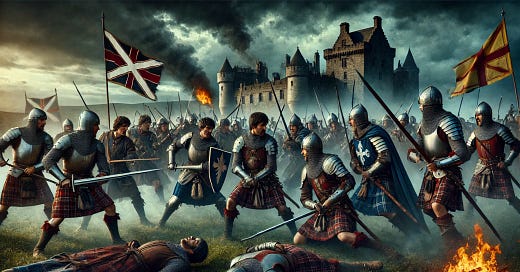For centuries, Renfrewshire, like much of Scotland, was plagued by bitter family feuds that often escalated into violent conflicts. These vendettas, driven by land disputes, political ambition, and personal grievances, turned the region into a battleground where bloodshed was common, and justice was often dictated by the sword rather than the law.
The feuds, most notably between the Montgomeries and Cunninghams, the Semples and Lennoxes, and other prominent families, shaped the social and political landscape of Renfrewshire. These wars were not just clashes between individuals; they were multi-generational conflicts that saw castles burned, towns pillaged, and entire families exterminated in the pursuit of vengeance.
This blog delves into the origins, major events, and eventual decline of the blood feuds that once terrorized Renfrewshire, shedding light on a dark but fascinating chapter in Scottish history.
Origins of the Blood Feuds in Renfrewshire
Scotland in the 14th, 15th, and 16th centuries was a land of fragmented power, where noble families ruled over their lands with near-absolute authority. While the monarchy technically held control, the king’s influence was often weak, allowing local lords to wage private wars unchecked.
Renfrewshire’s feuds often began as disputes over titles, land, or political influence. One of the most notorious conflicts was the battle for the office of Bailie of the Barony of Cunningham, a powerful legal and administrative position that controlled large areas of land. This role became a point of contention between the Montgomeries of Eglinton and the Cunninghams of Glencairn, leading to one of the bloodiest feuds in Scottish history.
Similarly, the Semples of Castle Semple were embroiled in constant skirmishes with the Lennox family, leading to raids, assassinations, and brutal retaliation. In many cases, these feuds were fueled by longstanding grudges, where the cycle of violence perpetuated itself through generations.
Key Feuds and Their Infamous Battles
The Montgomerie-Cunningham Feud
Perhaps the most famous feud in Renfrewshire, the Montgomerie-Cunningham rivalry lasted for over 200 years. It began in the late 14th century when Sir Hugh Eglinton, an ancestor of the Montgomeries, was appointed Bailie of the Barony of Cunningham by the Scottish crown. The Cunninghams disputed this appointment, claiming ancestral rights to the position.
This feud saw acts of arson, ambushes, and political maneuvering. One of the most shocking events occurred in 1586, when Hugh, 4th Earl of Eglinton, was assassinated by the Cunninghams in a carefully orchestrated ambush. The earl was traveling with only a small retinue when David Cunningham of Robertland and his men attacked, killing him in cold blood.
The Montgomeries retaliated with ruthless violence, launching raids on Cunningham lands, destroying properties, and executing their rivals. Despite multiple attempts at royal intervention, including decrees by King James VI, the feud continued into the early 17th century.
The Semple Feuds: War on Multiple Fronts
The Semples of Castle Semple were involved in numerous feuds, most notably against the Lennoxes, Houstouns, and Maxwells. Their wars were characterized by murderous ambushes, raids on castles, and battles fought in the streets of Renfrewshire towns.
One of the most dramatic incidents occurred in 1533, when William Cunningham of Craigends was assassinated by a faction led by the Semples. King James V, who was actively trying to control these feuds, took drastic measures, ordering the arrest and execution of several Semple retainers. However, despite these efforts, the feud continued for decades.
In another act of open defiance, William, Lord Semple, entered Edinburgh with 586 armed men and murdered a Dutch merchant near the Tolbooth. Although he was officially indicted for treason, King James V mysteriously granted him a nineteen-year respite, further illustrating how royal authority often struggled to control the warring clans.
The Role of the Crown and the Church in Ending the Feuds
Scottish monarchs were often powerless to end these feuds due to their reliance on noble families for military support. Even when the crown passed laws against private wars, enforcement was weak, and local lords continued their conflicts with impunity.
The Church attempted to intervene by forcing warring families to swear oaths of peace under threat of excommunication. In 1609, King James VI ordered a formal reconciliation between the Montgomeries and Cunninghams on Glasgow Green, where nobles from both sides, accompanied by armed guards, met under the watchful eyes of the Privy Council.
Although this public reconciliation reduced large-scale battles, smaller acts of violence and revenge killings continued for decades. Eventually, as Scotland moved towards a more centralized legal system and feudal power declined, the feuds faded into history.
Legacy of the Feuds in Modern Scotland
The blood feuds of Renfrewshire left a lasting mark on the region. Many of the castles and estates that were burned down during these conflicts have been restored, while others remain in ruins, serving as eerie reminders of the past.
Additionally, the feuds contributed to the centralization of royal authority. The failures of the nobility to maintain peace gave kings like James VI and Charles I more justification to enforce stricter laws, which ultimately ended the era of private warfare in Scotland.
In modern times, the names of the Montgomeries, Cunninghams, Semples, and Lennoxes remain prominent in Scottish history, with their descendants often playing important roles in politics and business. While the days of sword fights and castle raids are long gone, the legacy of these feuds still lingers in Scottish folklore, literature, and family traditions.
Conclusion
The blood feuds of Renfrewshire were a testament to the brutality and lawlessness of medieval Scotland. These conflicts, fueled by revenge, ambition, and power, shaped the history of the region for centuries. While time has softened these rivalries, the stories of betrayal, murder, and retribution continue to fascinate historians and locals alike.
The echoes of the past remain in the ruins of burned castles, in the ballads of old, and in the very landscape where these warriors once fought. Renfrewshire’s history is deeply intertwined with these feuds, serving as a reminder of a time when loyalty to kin meant everything—and vengeance was the ultimate law.





